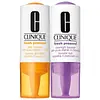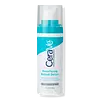Clinique Fresh Pressed Clinical™ Daily + Overnight Boosters with Pure Vitamin C 10% + A (Retinol) Versus CeraVe Resurfacing Retinol Serum
What's inside
What's inside
 Key Ingredients
Key Ingredients

 Benefits
Benefits

 Concerns
Concerns

 Ingredients Side-by-side
Ingredients Side-by-side

Water
Skin ConditioningAscorbic Acid
AntioxidantGlycerin
HumectantDimethicone
EmollientSqualane
EmollientButylene Glycol
HumectantDipropylene Glycol
HumectantAcetyl Glucosamine
Skin ConditioningCucumis Sativus Fruit Extract
EmollientHordeum Vulgare Extract
EmollientMorus Nigra Root Extract
Skin ConditioningSaccharum Officinarum Extract
MoisturisingLaminaria Digitata Extract
Skin ProtectingScutellaria Baicalensis Root Extract
AstringentAcetyl Hexapeptide-8
HumectantVitis Vinifera Fruit Extract
Skin ConditioningAlgae Extract
EmollientPalmitoyl Hexapeptide-12
Skin ConditioningPalmitoyl Tripeptide-1
Skin ConditioningPalmitoyl Tetrapeptide-7
Skin ConditioningAlcaligenes Polysaccharides
EmollientCaffeine
Skin ConditioningSucrose
HumectantLactis Proteinum
Skin ConditioningBetaine
HumectantSalicylic Acid
MaskingGlycine Soja Protein
EmulsifyingSodium Hyaluronate
HumectantCaprylyl Glycol
EmollientSigesbeckia Orientalis Extract
Skin ConditioningBis-PEG-18 Methyl Ether Dimethyl Silane
EmollientPropylene Glycol Dicaprate
EmollientHelianthus Annuus Seedcake
AbrasiveAllyl Methacrylates Crosspolymer
Emulsion StabilisingCarbomer
Emulsion StabilisingGlyceryl Polymethacrylate
Tromethamine
BufferingXanthan Gum
EmulsifyingPotassium Sorbate
PreservativePEG-8
HumectantPolysorbate 20
EmulsifyingSodium Citrate
BufferingDisodium EDTA
Phenoxyethanol
PreservativeGlycine Soja Oil
EmollientVinyl Dimethicone/Methicone Silsesquioxane Crosspolymer
Methyl Trimethicone
Skin ConditioningLauryl PEG-9 Polydimethylsiloxyethyl Dimethicone
Skin ConditioningPolysilicone-11
Methyl Gluceth-20
HumectantRetinol
Skin ConditioningOenothera Biennis Flower Extract
AstringentLaminaria Saccharina Extract
Skin ProtectingGelidiella Acerosa Extract
Skin ProtectingCholesterol
EmollientSalvia Sclarea Extract
AntiseborrhoeicAminopropyl Ascorbyl Phosphate
AntioxidantPlankton Extract
Skin ConditioningGlycine Soja Seed Extract
Skin ConditioningMicrococcus Lysate
Skin ConditioningHypnea Musciformis Extract
Skin ProtectingTocopheryl Acetate
AntioxidantSodium Hydroxide
BufferingCalcium Chloride
AstringentAmmonium Acryloyldimethyltaurate/Vp Copolymer
Lecithin
EmollientBHT
AntioxidantSodium Benzoate
MaskingWater, Ascorbic Acid, Glycerin, Dimethicone, Squalane, Butylene Glycol, Dipropylene Glycol, Acetyl Glucosamine, Cucumis Sativus Fruit Extract, Hordeum Vulgare Extract, Morus Nigra Root Extract, Saccharum Officinarum Extract, Laminaria Digitata Extract, Scutellaria Baicalensis Root Extract, Acetyl Hexapeptide-8, Vitis Vinifera Fruit Extract, Algae Extract, Palmitoyl Hexapeptide-12, Palmitoyl Tripeptide-1, Palmitoyl Tetrapeptide-7, Alcaligenes Polysaccharides, Caffeine, Sucrose, Lactis Proteinum, Betaine, Salicylic Acid, Glycine Soja Protein, Sodium Hyaluronate, Caprylyl Glycol, Sigesbeckia Orientalis Extract, Bis-PEG-18 Methyl Ether Dimethyl Silane, Propylene Glycol Dicaprate, Helianthus Annuus Seedcake, Allyl Methacrylates Crosspolymer, Carbomer, Glyceryl Polymethacrylate, Tromethamine, Xanthan Gum, Potassium Sorbate, PEG-8, Polysorbate 20, Sodium Citrate, Disodium EDTA, Phenoxyethanol, Glycine Soja Oil, Vinyl Dimethicone/Methicone Silsesquioxane Crosspolymer, Methyl Trimethicone, Lauryl PEG-9 Polydimethylsiloxyethyl Dimethicone, Polysilicone-11, Methyl Gluceth-20, Retinol, Oenothera Biennis Flower Extract, Laminaria Saccharina Extract, Gelidiella Acerosa Extract, Cholesterol, Salvia Sclarea Extract, Aminopropyl Ascorbyl Phosphate, Plankton Extract, Glycine Soja Seed Extract, Micrococcus Lysate, Hypnea Musciformis Extract, Tocopheryl Acetate, Sodium Hydroxide, Calcium Chloride, Ammonium Acryloyldimethyltaurate/Vp Copolymer, Lecithin, BHT, Sodium Benzoate
Water
Skin ConditioningPropanediol
SolventDimethicone
EmollientCetearyl Ethylhexanoate
EmollientNiacinamide
SmoothingAmmonium Polyacryloyldimethyl Taurate
Emulsion StabilisingDipotassium Glycyrrhizate
HumectantHydrogenated Lecithin
EmulsifyingPotassium Phosphate
BufferingCeramide NP
Skin ConditioningCeramide AP
Skin ConditioningCeramide EOP
Skin ConditioningCarbomer
Emulsion StabilisingCetearyl Alcohol
EmollientBehentrimonium Methosulfate
Dimethiconol
EmollientLecithin
EmollientSodium Citrate
BufferingRetinol
Skin ConditioningSodium Hyaluronate
HumectantSodium Lauroyl Lactylate
EmulsifyingCholesterol
EmollientPhenoxyethanol
PreservativeAlcohol
AntimicrobialIsopropyl Myristate
EmollientCaprylyl Glycol
EmollientCitric Acid
BufferingTrisodium Ethylenediamine Disuccinate
Pentylene Glycol
Skin ConditioningPhytosphingosine
Skin ConditioningXanthan Gum
EmulsifyingPolysorbate 20
EmulsifyingEthylhexylglycerin
Skin ConditioningWater, Propanediol, Dimethicone, Cetearyl Ethylhexanoate, Niacinamide, Ammonium Polyacryloyldimethyl Taurate, Dipotassium Glycyrrhizate, Hydrogenated Lecithin, Potassium Phosphate, Ceramide NP, Ceramide AP, Ceramide EOP, Carbomer, Cetearyl Alcohol, Behentrimonium Methosulfate, Dimethiconol, Lecithin, Sodium Citrate, Retinol, Sodium Hyaluronate, Sodium Lauroyl Lactylate, Cholesterol, Phenoxyethanol, Alcohol, Isopropyl Myristate, Caprylyl Glycol, Citric Acid, Trisodium Ethylenediamine Disuccinate, Pentylene Glycol, Phytosphingosine, Xanthan Gum, Polysorbate 20, Ethylhexylglycerin
 Reviews
Reviews

Ingredients Explained
These ingredients are found in both products.
Ingredients higher up in an ingredient list are typically present in a larger amount.
Caprylyl Glycol is a humectant and emollient, meaning it attracts and preserves moisture.
It is a common ingredient in many products, especially those designed to hydrate skin. The primary benefits are retaining moisture, skin softening, and promoting a healthy skin barrier.
Though Caprylyl Glycol is an alcohol derived from fatty acids, it is not the kind that can dry out skin.
This ingredient is also used as a preservative to extend the life of products. It has slight antimicrobial properties.
Learn more about Caprylyl GlycolCarbomer is a polymer of acrylic acid. Its main role is to create a gel consistency.
A high amount of carbomer can cause pilling or balling up of products. Don't worry, most products contain 1% or less of carbomer.
Cholesterol is a class of organic molecules called lipids. It helps hydrate your skin and is essential to having a healthy skin barrier.
Our skin naturally contains cholesterol in the outermost layer. Besides cholesterol, it also contains ceramides and fatty acids. Cholesterol makes up about 1/4 of your skin's outer layer and barrier. Your skin barrier is responsible for keeping allergens and microbes out. Having a healthy skin barrier is also responsible for keeping your skin firm and plump.
Our bodies use cholestrol to create vitamin D, steroid hormones, and more.
Learn more about CholesterolDimethicone is a type of synthetic silicone created from natural materials such as quartz.
What it does:
Dimethicone comes in different viscosities:
Depending on the viscosity, dimethicone has different properties.
Ingredients lists don't always show which type is used, so we recommend reaching out to the brand if you have questions about the viscosity.
This ingredient is unlikely to cause irritation because it does not get absorbed into skin. However, people with silicone allergies should be careful about using this ingredient.
Note: Dimethicone may contribute to pilling. This is because it is not oil or water soluble, so pilling may occur when layered with products. When mixed with heavy oils in a formula, the outcome is also quite greasy.
Learn more about DimethiconeLecithin is a term for a group of substances found in the cell membranes of plants, animals, and humans. They are made up of mixture of phospholipids.
This ingredient has emollient and emulsifying properties.
As an emollient, lecithen helps soften the skin and creates a barrier to keep moisture in.
As an emulsifier, it also helps prevent water and oil ingredients from separating. Lecithin can also help ingredients be better absorbed by the skin.
This is because the phospholipids in lecithin produce liposomes. Liposomes help other ingredients get through the skin barrier.
Depending on the source of this ingredient, lecithin may not be fungal acne safe. This is because some sources of lecithin come from soybean oil, which may feed the malassezia yeast that feeds fungal acne.
We recommend reaching out to the brand you are purchasing from to inquire about the source of their lecithin.
Some other names for this ingredient include soy lecithin and deoiled soy lecithin.
Learn more about LecithinPhenoxyethanol is a preservative that has germicide, antimicrobial, and aromatic properties. Studies show that phenoxyethanol can prevent microbial growth. By itself, it has a scent that is similar to that of a rose.
It's often used in formulations along with Caprylyl Glycol to preserve the shelf life of products.
Polysorbate 20 is made by combining ethoxylation of sorbitan, ethylene oxide, and lauric acid. It is a mild cleansing agent, surfactant, and emulsifier.
As a surfactant, it helps collect dirt and oils for washing. Emulsifiers prevent oils and water from separating.
Polysorbate 20 also adds scent to a product. Since it is made using sorbitol, it has a sweet scent. Sorbitol can also be found in fruits such as apples and peaches.
The lauric acid used to create Polysorbate 20 is often derived from coconuts.
Polysorbate 20 may not be fungal acne safe.
Learn more about Polysorbate 20Retinol is a gold-standard ingredient for anti-aging. It is a form of Vitamin A and belongs to the class of retinoids that also includes tretinoin.
Why is retinol famous?
It has the most scientific studies backing up its skin benefits out of all the non-prescription ingredients.
Retinol is proven to:
This is why retinol is effective at removing wrinkles, fading dark spots, treating acne, and reducing the appearance of pores.
Studies show retinol is less effective when exposed to UV. Be sure to look for appropriate packaging to keep your retinol potent (similar to Vitamin C).
Using retinol or any retinoids will increase sun-sensitivity in the first few months. Though studies show retinoids increase your skin's natural SPF with continuous use, it is best to always wear sunscreen and sun-protection.
We recommend speaking with a medical professional about using this ingredient during pregnancy.
Retinol may cause irritation in some people, so be sure to patch test. Experts recommend 'ramping up' retinol use: start using this ingredient once a week and work up to using it daily.
Read about Tretinoin
Learn more about RetinolSodium Citrate is the sodium salts of citric acid. In skincare, it is used to alter pH levels and acts as a preservative.
Its main functions are to maintain the pH of a product and neutralize metal ions.
The acidity of our skin is maintained by our glands and skin biome; normal pH level of skin is slightly acidic (~4.75-5.5).
Being slightly acidic allows our skin to create an "acid mantle". This acid mantle is a thin barrier that protects our skin from bacteria and contaminants.
Learn more about Sodium CitrateSodium Hyaluronate is hyaluronic acid's salt form. It is commonly derived from the sodium salt of hyaluronic acid.
Like hyaluronic acid, it is great at holding water and acts as a humectant. This makes it a great skin hydrating ingredient.
Sodium Hyaluronate is naturally occurring in our bodies and is mostly found in eye fluid and joints.
These are some other common types of Hyaluronic Acid:
Learn more about Sodium HyaluronateWater. It's the most common cosmetic ingredient of all. You'll usually see it at the top of ingredient lists, meaning that it makes up the largest part of the product.
So why is it so popular? Water most often acts as a solvent - this means that it helps dissolve other ingredients into the formulation.
You'll also recognize water as that liquid we all need to stay alive. If you see this, drink a glass of water. Stay hydrated!
Learn more about WaterXanthan gum is used as a stabilizer and thickener within cosmetic products. It helps give products a sticky, thick feeling - preventing them from being too runny.
On the technical side of things, xanthan gum is a polysaccharide - a combination consisting of multiple sugar molecules bonded together.
Xanthan gum is a pretty common and great ingredient. It is a natural, non-toxic, non-irritating ingredient that is also commonly used in food products.
Learn more about Xanthan Gum